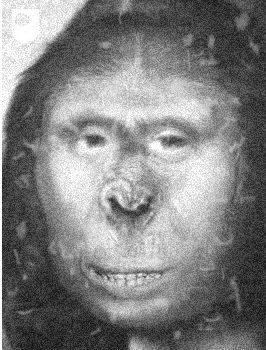
November 8, 2013
by Christopher Noël

While the first two episodes of the BBC series “Bigfoot Files” proved a disappointment for North American researchers, and for followers of the Yeti, last Sunday’s episode, focused on Russia, was quite another story.
The central mystery was Zana, a “wild woman” captured in the Caucasus Mountains in about 1850 and kept in captivity for several decades. She was described by multiple witnesses as being six foot six inches tall, very stoutly built, with a pronounced brow ridge and large, deep-set eyes. And here is the key detail: Except for her face, she was entirely covered in thick, reddish-brown hair.
During her lifetime, she bore at least four children by local men and the skull of a son, Khwit, has been recovered. From one of Khwit’s teeth, Professor Bryan Sykes was able to test a certain type of genetic material—mitochondrial DNA (or mtDNA)—that reveals only maternal ancestry. Khwit’s mtDNA must be identical to his mother’s, and hers identical to her mother’s, and so on, back through time. After enough generations have elapsed, however, one can notice mutations occurring.
As Professor Sykes explains in his excellent book, The Seven Daughters of Eve, the mutation rate for mtDNA is highly predictable, allowing researchers to determine quite accurately just how far back a given maternal line goes, and even generally where it came from, which group within the human evolutionary spread across our planet.
Another name for this mutation rate is the “molecular clock,” and over the past twenty years, genetic science has learned to read it with increasing refinement; indeed, customers can now have their mtDNA inexpensively analyzed in order to learn much about the history, and the geographical stomping ground, of their own distant ancestors.
But back to Bigfoot. In the most recent episode, Professor Sykes revealed that, thanks to the mtDNA recovered from her son’s tooth, the Zana mystery is partially solved: Her “people” came from southern Africa… but when? As if mtDNA does not famously enable us to determine exactly such an answer, Sykes ignores this angle altogether and shifts instead to a much cruder clue.
“Bryan noticed some unusual features on Khwit’s skull,” Mark Evans narrates, “very wide eye sockets and an elevated brow ridge that could suggest ancient, as opposed to modern, human origins. And he was starting to toy with a thought-provoking alternative notion.”
Sykes then shares it: “Maybe she isn’t an African of recent origin at all but one from a migration out of Africa many thousands, perhaps tens of thousands of years ago, and she comes from a relict population.”
Now, let us take the full measure of this “speculation.” If true, it would mean nothing less than that Zana was a member of a pre-modern human group mistakenly thought to be extinct—precisely what many researchers have long pointed to as the origin story of Sasquatch itself (those researchers, anyway, who don’t place this creature in the “ape” category). Keep in mind, too, that Professor Sykes has the mtDNA results from Khwit’s tooth (a scientific paper on the topic is awaiting publication) and therefore already knows the answer to whether Zana hails from a modern or an ancient period of time.
Bryan Sykes is an extremely prudent man—a conservative, world-class scientific mind. Thus, he would not have allowed himself to speculate, on international television, that Zana may have derived from a relict line of ancient Homo sapiens if the mtDNA sequences did not support this very conclusion. (It’s a conclusion, incidentally, that falls right in line with Melba Ketchum’s mtDNA findings.) If his test results had demonstrated a modern origin for Zana, it would be highly irresponsible and out of character for him even to entertain such a radically divergent hypothesis.
And finally, if Zana was merely a modern person and not, in fact, a Sasquatch (or Alma, in the Russian context), then why was she (as described) a dead ringer for the figure in the Patterson-Gimlin Film—more than a century before anyone had laid eyes upon Patty?
About Christopher Noël
Christopher Noël is the author of Sasquatch Rising 2013 and editor of the newly released anthology How Sasquatch Matters: Writers Respond to the New Natural Order.
Christopher Noël holds a Master’s degree in Philosophy from Yale. Noël is a freelance editor (ChristopherNoel.info) and lives with his daughter in Vermont’s Northeast Kingdom.
Filed under Abominable Snowman, Almas, Bigfoot, Bigfoot Report, Cryptozoologists, Cryptozoology, Evidence, Folklore, Photos, Pop Culture, Sasquatch, Television, Yeti